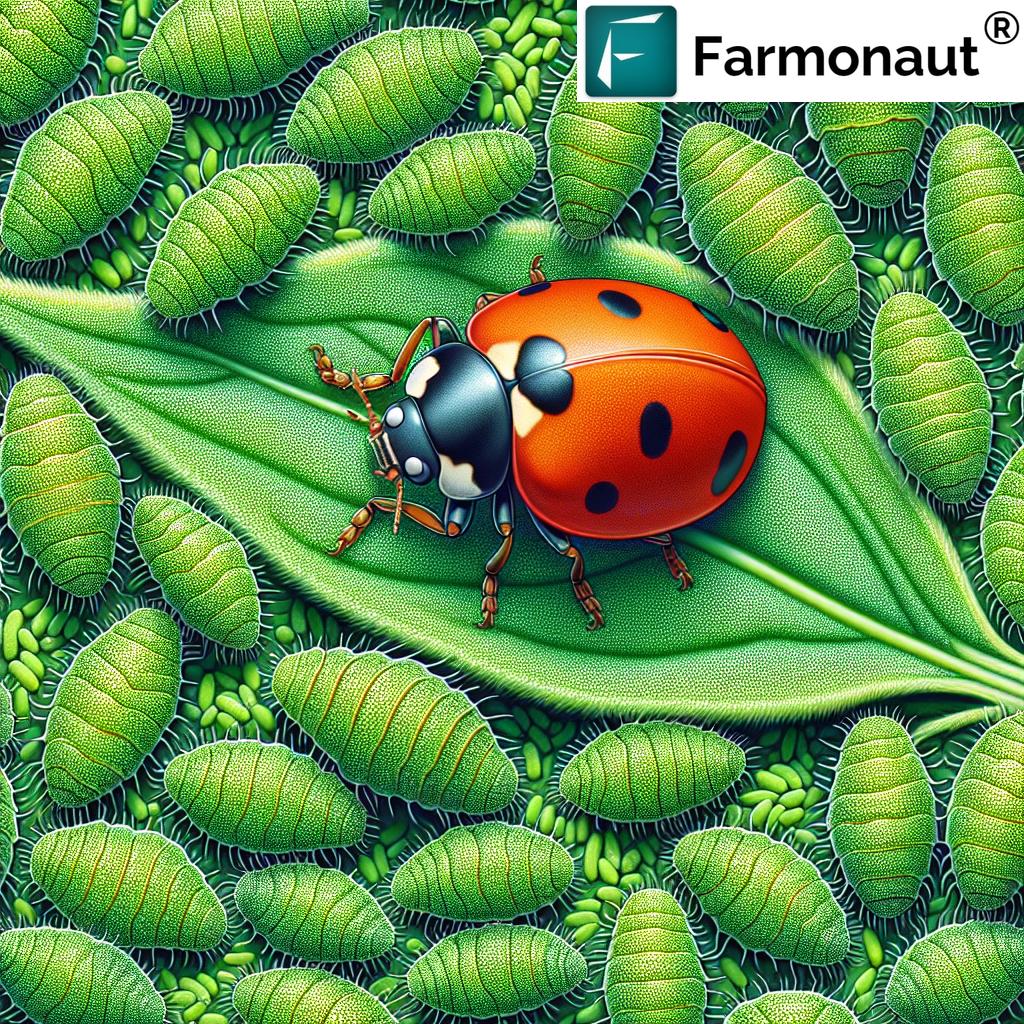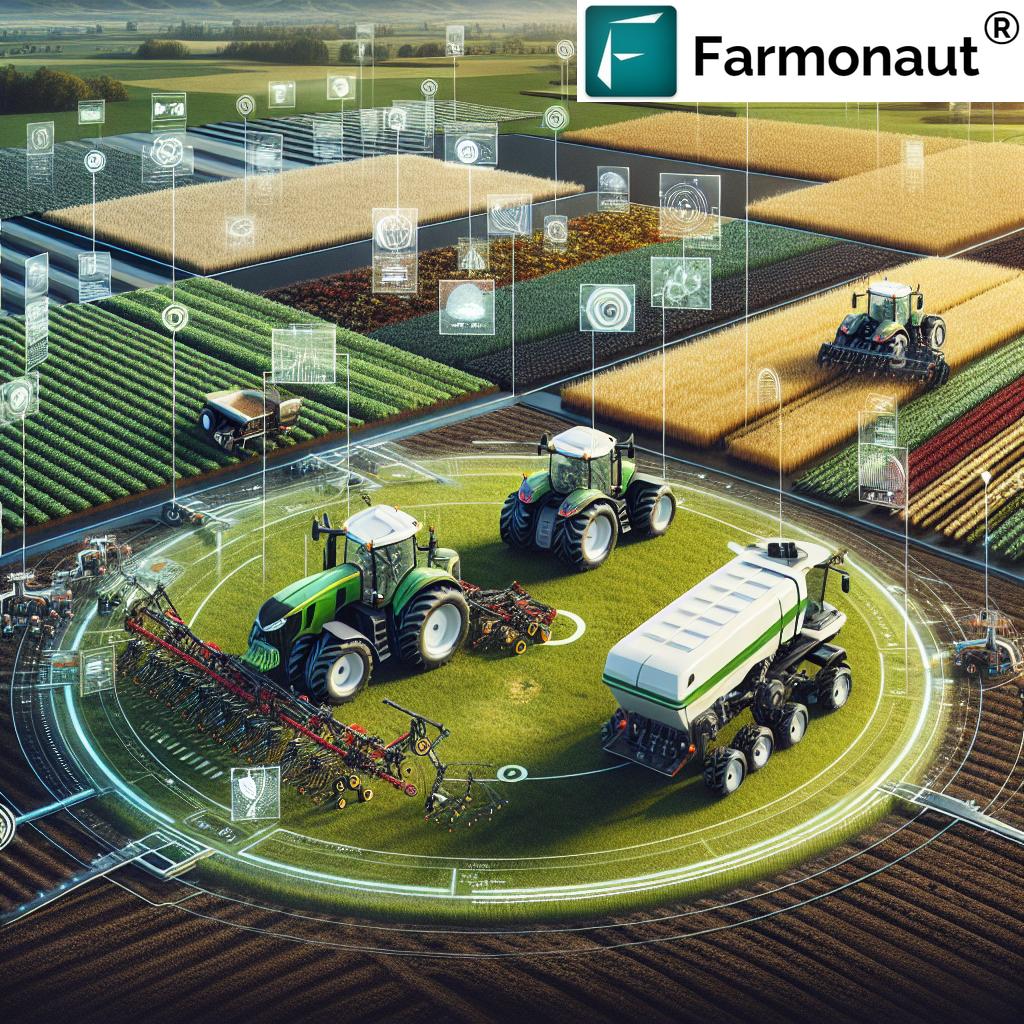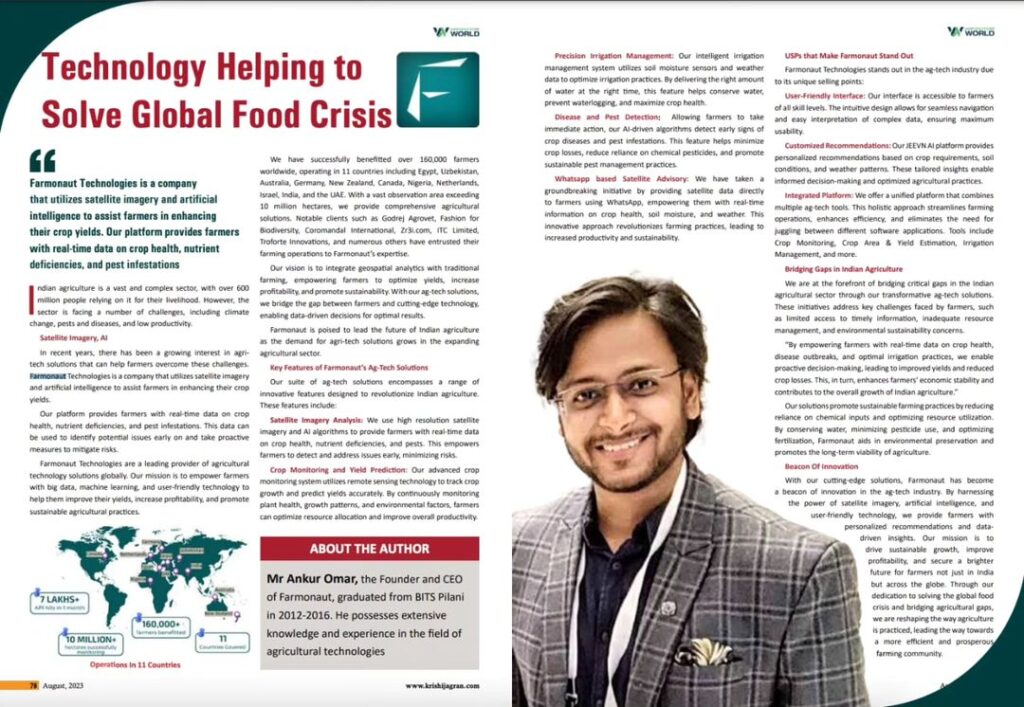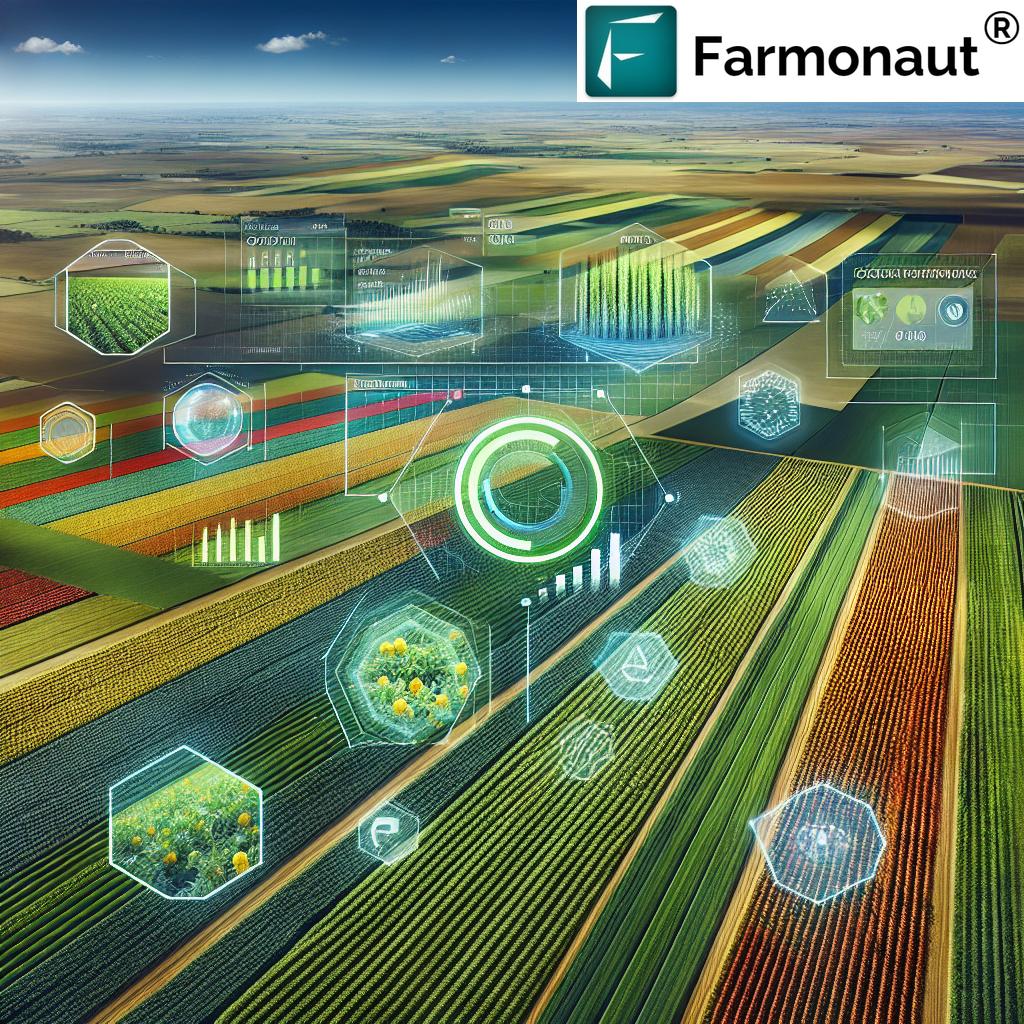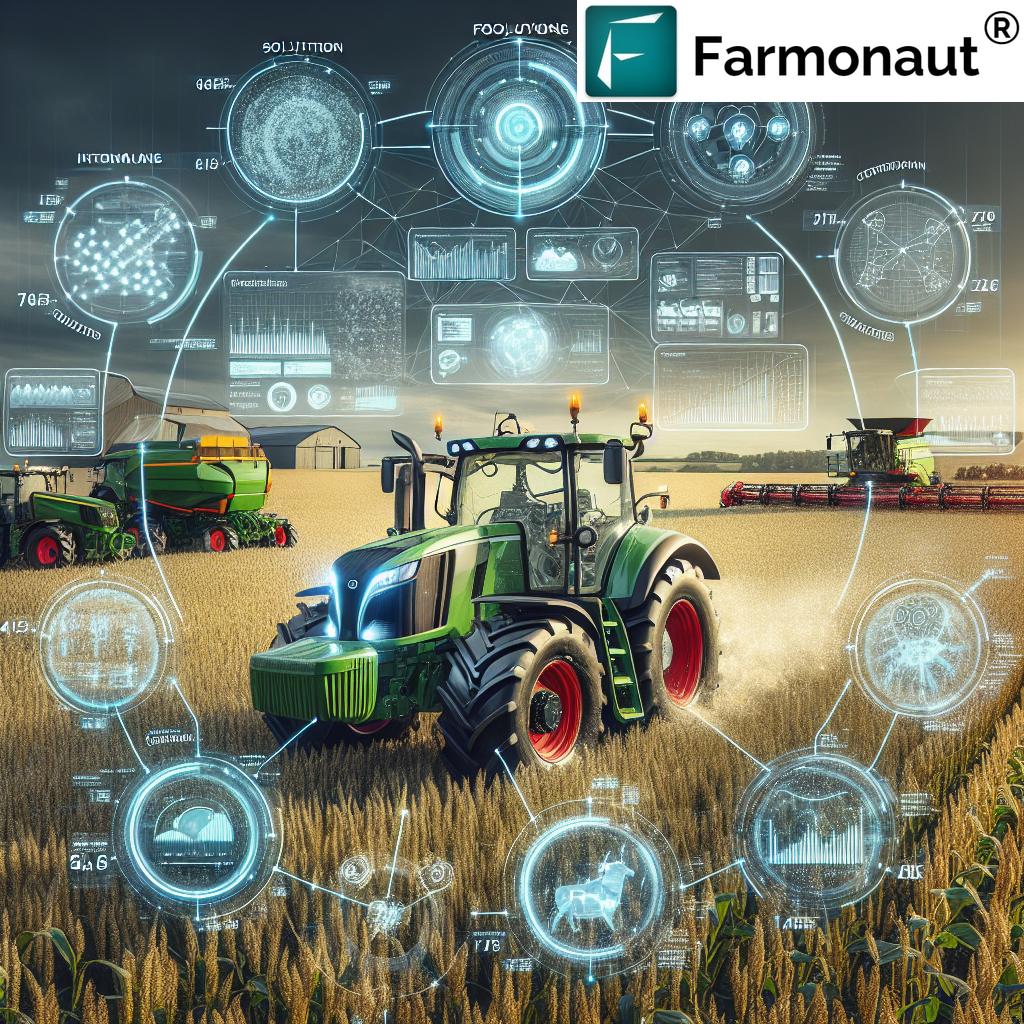Connected Agriculture Platforms: Resilient Farming 2025
Table of Contents
- Introduction
- What are Connected Agriculture Platforms?
- Core Components of Connected Agriculture Platforms in 2025
- Farming Platforms & Intelligent Data Integration
- Revolutionizing Modern Farming with Artificial Intelligence & Analytics
- Exploring Technology Innovation in Connected Agriculture: Videos
- Connected Agriculture Software & Enhanced User Experience
- Sustainability & Resilience: The Green Edge of Connected Agriculture
- Key Benefits of Connected Agriculture Platforms in 2025 (Comparative Table)
- Farmonaut Satellite-Driven Connected Solutions for Agriculture
- Making Connected Farming Platforms Accessible & Affordable
- Future Trends & Challenges: Connected Agriculture Platforms Beyond 2025
- Frequently Asked Questions: Connected Agriculture Platforms
- Conclusion
“By 2025, over 70% of farms are expected to use connected agriculture platforms for real-time data-driven decisions.”
Introduction: Connected Agriculture Platforms Transforming Farming in 2025
As we step decisively into 2025, connected agriculture platforms stand at the forefront of a profound technological transformation. These systems are defining how agricultural operations are managed, optimized, and made resilient against future challenges.
The digitization of agriculture, spearheaded by connected agriculture software and advanced farming data platforms, is revolutionizing the entire value chain—from field to fork. With the integration of real-time data collection, cloud-based analytics, and artificial intelligence, these platforms empower farmers, agronomists, and agri-businesses with actionable intelligence. Their adoption is enabling smarter, more sustainable, and highly productive farming systems.
In this blog, we’ll explore how connected innovations in agriculture are helping farmers overcome resource constraints, adapt to changing climate, and meet the growing demand for food safety and traceability. We’ll also unveil how platforms like Farmonaut are bringing satellite-driven insights to the heart of digital agriculture.
“Farming data software in 2025 can analyze up to 1 million data points per hectare for precision agriculture.”
What are Connected Agriculture Platforms?
Connected agriculture platforms are sophisticated, unified digital systems integrating data collected from a diverse network of sensors, drones, satellite imagery, weather stations, and even agricultural machinery. These platforms allow for precise monitoring, optimized interventions, and robust farm management by leveraging advanced analytics and AI-powered solutions.
- They combine hardware (such as IoT devices, remote sensors, and autonomous machinery) with flexible software applications.
- By aggregating and synthesizing data from multiple sources, these platforms deliver a holistic view of farm conditions.
- Applications offer actionable insights—on everything from soil moisture to pest pressure, carbon emissions, and equipment status.
- Mobile, cloud-based interfaces make these platforms accessible to farmers, agronomists, and supply chain stakeholders worldwide, including in rural and emerging economies.
*One of the defining features of these platforms is the ability to transform vast raw data into actionable intelligence that enables timely and precise farming interventions for yield, sustainability, and profitability.*
Core Components of Connected Agriculture Platforms in 2025
Let’s break down key elements and technologies that power leading farming platforms and agriculture data platforms:
-
Data Collection & Integration
- Aggregates high-frequency data from sensors (soil, moisture, weather), drones, satellites, and machinery.
- Essential for building a dynamic, real-time digital representation of the farm.
-
Advanced Analytics & Artificial Intelligence (AI)
- Processes large volumes of raw data using machine learning models and AI to uncover actionable intelligence.
- Delivers decision support for crop health, input optimization, irrigation, pest management, and more.
-
Cloud Computing & Mobile Accessibility
- Cloud-based platforms allow seamless storage, analysis, and remote access to data—supporting collaboration across the value chain.
- Mobile applications enable on-the-ground decision-making, even in rural settings.
-
Automation & Connected Machinery
- IoT-enabled devices and smart machinery automate fertilization, irrigation, spraying, and more—reducing labor, resource use, and errors.
-
Compliance, Financial, and Supply Chain Integration
- Modules for input management, crop planning, compliance reporting, and financial tracking help optimize operational and economic outcomes.
- Connected to supply chain partners for seamless movement of information and produce.
Farming Platforms & Intelligent Data Integration
The backbone of modern agriculture in 2025 is intelligent data integration. Each connected agriculture platform brings together information from disparate sources—sensors, drones, tractors, irrigation systems, satellites, and even local weather stations—creating powerful synergies and new insights.
Key Types of Data Sources in Connected Platforms
- Soil Sensors: Measure moisture, pH, nutrients, and temperature—enabling precise irrigation and fertilization that improves soil health.
- Weather Stations: Provide hyper-local predictions, rainfall alerts, and help forecast disease or pest outbreaks, allowing farmers to plan interventions.
- Drones & Satellite Imagery: Offer timely, landscape-scale perspectives for monitoring crop health, pest or disease pressure, and water stress.
- IoT-Connected Machinery: Automatically logs operational data, tracks equipment health, and optimizes resource allocation.
With data platforms capable of synthesizing large volumes of information in near real time, farming operations have never been more precise and adaptive.
Benefits for Crop Management & Resource Utilization
- More accurate crop planning and variety selection through historic and predictive analytics.
- Monitoring pest populations with digital traps and AI-powered image recognition, precisely targeting application of pesticides and minimizing environmental impact.
- Efficient irrigation based on soil sensor data, reducing unnecessary water use, improving plant health and resilience.
- Input management modules that track fertilizer and chemical use, enabling compliance and sustainability reporting.
Revolutionizing Modern Farming with Artificial Intelligence & Analytics
Central to the digital transformation of agriculture is artificial intelligence and advanced data analytics. These technologies have brought about a new era of connected innovations in agriculture by:
- Processing massive datasets from farm sensors, satellites, and machinery in seconds.
- Enabling real-time analysis for in-field decision-making and automated interventions.
- Providing AI-driven advisories for soil management, pest and disease identification, precision input application, and harvest optimization.
- Predicting yield, disease outbreaks, and resource needs through machine learning-powered forecasting.
As a result, farming platforms in 2025 can deliver farm-specific, actionable intelligence, maximizing yields while minimizing waste and costs.
Exploring Technology Innovation in Connected Agriculture: Videos
Discover more about the latest advancements in connected agriculture platforms and digital farming software with these insightful videos. They showcase AI, satellite technology, data platforms, and game-changing solutions that are enabling more resilient and sustainable farms in 2025.
Unlock continuous, real-time crop health monitoring with Farmonaut’s Large Scale Farm Management & Crop Monitoring Platform.
Intuitive dashboards, dynamic NDVI maps, and robust data management empower agronomists, farm operators, and estate managers in 2025 to optimize yield and resource use efficiently.
Connected Agriculture Software & Enhanced User Experience
Modern connected agriculture software is designed with the end-user in mind, ensuring that farmers and support teams—regardless of their tech proficiency—can easily adopt, access, and benefit from digital farming tools. Key features of this new generation of agriculture data platforms include:
- User-friendly Interfaces: Well-designed mobile & web applications feature intuitive modules for crop planning, input management, and field reporting.
- Cloud & API Integration: Secure cloud storage fosters collaboration and allows integration with third-party systems through open APIs.
- Developers: Access Farmonaut Satellite & Weather API and view the API developer documentation to embed advanced farm intelligence into custom apps in 2025.
- Modular Solutions: Applications are customizable, letting users activate modules for financial tracking, compliance, or detailed resource management as required.
- Scalability: Platforms are built to serve everything from single smallholdings to thousands of hectares using the same underlying system.
- Data Security: Robust privacy, security, and access control mechanisms ensure farmers always maintain control over their farm data.
Looking for transparency and traceability in your agricultural supply chain?
Explore Farmonaut’s Blockchain-Based Product Traceability Platform.
Ensure authenticity, prevent fraud, and build consumer trust using secure blockchain records from field to market.
Sustainability & Resilience: The Green Edge of Connected Agriculture
One of the greatest promises of connected agriculture platforms in 2025 is their role in enabling sustainability and resilience. How do these systems empower sustainable agriculture?
- Precision Input Management: Minimizing over-application of fertilizers and chemicals, reducing runoff, soil degradation, and input costs.
- Water Use Efficiency: Soil moisture sensors and data-driven irrigation schedules can reduce water waste by up to 30%, vital for drought-prone regions.
- Carbon Footprint Reduction: Some platforms now trace carbon emissions and promote climate-smart practices. For example, Farmonaut’s Carbon Footprinting tool allows monitoring, benchmarking, and compliance reporting for agricultural sustainability initiatives.
- Resilience Against Climate Change: Climate-adaptive crop planning tools, yield forecasting, and risk monitoring help safeguard farm productivity as conditions shift.
- Rural Access: The democratization of these technologies, with affordable mobile platforms, is reducing the digital divide in rural and resource-constrained regions worldwide.
- Environmental Compliance: Enhanced digital monitoring ensures easier regulatory compliance and certification for sustainably managed farms.
Need to streamline operations and assets? Review Farmonaut’s Fleet & Resource Management Platform.
Optimize your equipment usage, reduce costs, and improve farm logistics for agriculture operations big or small—all with robust satellite-based monitoring and real-time fleet intelligence.
Key Benefits of Connected Agriculture Platforms in 2025 (Comparative Table)
| Functionality | Farmonaut | Platform A | Platform B |
|---|---|---|---|
| Yield Optimization | Up to +20% yield increase using real-time, satellite & AI crop health analytics | 10–15% yield improvement (sensor-driven) | Up to 15% yield increase |
| Sustainability Impact | 30% water use reduction, carbon tracking, compliance modules | 15% water saving, limited sustainability features | 20% water use reduction, partial environmental modules |
| Data Integration | Supports sensors, satellite, drones, blockchain, and IoT machinery | Primarily sensors & IoT devices | Satellite & sensor data, limited blockchain |
| Real-Time Monitoring | Data updates every 1-3 days; AI advisory in real time | Hourly to daily data latency | Real‑time sensors, weekly imagery |
| Cost Efficiency | Estimated annual savings up to $5,000/farm (subscription model) | OPEX efficiency, may require upfront hardware purchase | Annual savings $2,500–$3,000/farm |
Note: Quantitative values are indicative. Features may vary across platform providers.
Farmonaut Satellite-Driven Connected Solutions for Agriculture
Farmonaut stands out among connected agriculture platforms by making advanced, satellite-driven insights affordable and scalable for everyone—from smallholder farmers to global agribusinesses.
- Satellite-Based Monitoring: Our platform delivers multispectral imagery analysis, NDVI, and soil condition mapping, accessible via Android, iOS, and web apps for real-time crop health monitoring.
- AI Advisory Systems: The Jeevn AI Tool generates instant agronomic recommendations, weather forecasts, pest alerts, and productivity insights—enabling more confident decision-making and risk management in 2025 and beyond.
- Blockchain Traceability: We offer blockchain-backed traceability to guarantee crop authenticity and transparency throughout the agricultural supply chain.
- Environmental & Emissions Tracking: Our carbon footprinting tools help farms, agri-businesses, and governments comply with evolving environmental regulations and sustainability targets.
- Fleet & Resource Management: Optimize machinery use, monitor operational safety, and streamline logistics with our fleet management module.
Our goal is to democratize access to satellite-powered agriculture intelligence while directly addressing the productivity, sustainability, and transparency needs of our users in a digital-first era.
Learn how our Android, iOS, and browser-ready apps empower in-field monitoring and remote operations:
Get started with Farmonaut’s Crop Plantation and Advisory App
Need secure, satellite-verified data for crop loans and agricultural insurance?
Explore Farmonaut’s Crop Loan and Insurance Platform for rapid, accurate farm verification to support your financial needs in 2025.
Making Connected Farming Platforms Accessible & Affordable
The true potential of connected agriculture platforms will only be realized when they’re accessible to all farmers, including those in rural and smallholder contexts. Here’s how farming platforms are driving inclusivity in 2025:
- Mobile-first Solutions: By providing cross-platform mobile and browser apps, digital agriculture tools reach farmers where they are—even in areas with limited infrastructure.
- Affordable Subscription Models: Farmonaut and others have removed the need for high up-front hardware investments, instead offering robust tools via low-cost subscriptions.
- Open APIs: Developers and agri-tech companies can easily build localized applications using accessible APIs, adapting technology for diverse languages and requirements.
- Community Connectivity: Shared connectivity hubs and training programs empower rural communities to maximize their data assets and improve agricultural outcomes.
If you’re an agri-entrepreneur or rural innovator, API access is just a click away:
API Documentation & Samples
Future Trends & Challenges: Connected Agriculture Platforms Beyond 2025
As we look past 2025, the connected agriculture ecosystem is poised for even more technological transformation:
- Interoperability: Open-architecture platforms will enable seamless integration of devices, sensors, data streams, and software from multiple vendors—fostering innovation.
- Advanced AI & Machine Learning: As algorithms continue to improve, AI will power predictive models for disease, market trends, and resource management with increasing precision.
- Blockchain Everywhere: Blockchain will underpin all farm-to-fork traceability, finance, and regulatory processes—building unmatched trust in agriculture value chains.
- Decentralized & Edge Computing: Real-time edge analytics will bring fast, offline insights to even the most remote fields.
- Cybersecurity & Data Governance: With the explosion in farm data, privacy and security will be critical. Robust protocols and transparent data governance frameworks must keep pace.
- Sustainability Regulations: Future compliance will demand more automated tracking of carbon emissions, biodiversity, and circular resource flows.
- Human-Machine Collaboration: Automation will continue to grow, but human experience will remain vital—guiding the ethical and practical use of connected agriculture systems.
Challenges to Widespread Adoption
- Infrastructure Gaps: Unreliable connectivity or power supply in remote/rural regions.
- Digital Literacy: Older or traditionally trained farmers may need dedicated support to fully leverage these innovations.
- Data Ownership & Privacy: Ensuring that farmers maintain control and benefit from the value of their agricultural data.
- Initial Investment Concerns: Even low-cost subscriptions need to demonstrate clear ROI for smallholders.
- Regulatory Hurdles: Harmonization of standards for data, software, and traceability across different markets.
By addressing these challenges collectively, the sector will ensure connected platforms are engines of inclusive growth, food security, and sustainable development in agriculture.
Frequently Asked Questions: Connected Agriculture Platforms
A connected agriculture platform is a digital system that unifies data from sensors, drones, satellites, weather stations, and more, enabling farmers and agricultural businesses to monitor, analyze, and optimize their operations in real time.
Q2: How do connected agriculture platforms help optimize crop yield?
They synthesize large volumes of data to deliver actionable insights on soil status, pest risk, input levels, and growth trends, allowing precise interventions—thus improving yield and resource utilization.
Q3: Are these platforms accessible for smallholder and rural farmers?
Yes, many modern platforms—including Farmonaut—offer mobile-first, cloud-based software with language localization and affordable subscription plans designed for diverse farming contexts.
Q4: How is sustainability addressed in digital agriculture platforms?
By providing modules for carbon footprinting, water management, compliance reporting, and promoting reduced use of chemicals, connected platforms enable more environmentally responsible and resilient farming.
Q5: Are data privacy and security concerns addressed?
Leading platforms implement robust security protocols, encrypted communication, and give farmers ownership and control over their personal and operational data.
Q6: How can developers build on or integrate with these agricultural platforms?
Many solutions, such as Farmonaut, offer rich API access and developer documentation, allowing seamless integration of satellite, weather, and agronomy data into custom apps and tools.
Conclusion
Connected agriculture platforms in 2025 are not science fiction. They are the reality revolutionizing how food is grown, managed, and delivered worldwide. By harmonizing software, satellite and IoT-based data, analytics, and connected innovations in agriculture, these platforms are enabling resilient, sustainable, and highly productive farming operations.
Farmers, agronomists, agribusiness, and governments who embrace these technologies stand at the forefront of a new age—one where resilient farming is powered by data, intelligence, and a holistic digital approach. The future of agriculture belongs to those leveraging connected platforms to overcome challenges, minimize impact, and ensure food security for generations to come.
Ready to transform your agricultural operations?
Get started with Farmonaut’s Connected Agriculture Platform today.
Empowering agriculture through digital innovation, data-driven insights, and platform-based resilience—that’s the future we’re building together in 2025 and beyond.





